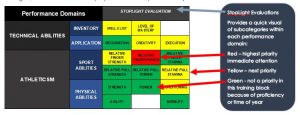DELIBERATE PRACTICE: MAKING SURE WHAT YOU DO MAKES A DIFFERENCE
In the last installment of the coach’s toolbox we looked at creating a Yearly Training Plan (YTP). This month we explore an important tool that helps prioritize training areas, and measure progress to ensure that what an athlete does in training and practice is working:
THE INDIVIDUAL PERFORMANCE PLAN (IPP)
LINK TO TEMPLATE HERE
Continuing on the analogy from Edition #1, if a YTP is the overall plan for a multi-day journey that helps plot the connection between all destinations along the way, then the IPPs are the individual day trip plans that prioritize what will be collected, provide directions, and measure progress.
Here is a sample IPP for a Combined Athlete (click on the images to see them full screen):
Again, we can zoom in on a couple parts of the IPP to provide detail:
KEY PERFORMANCE INDICATORS (KPIs)
Key Performance Indicators are measurable outcomes that show progress towards a goal. Each KPI is in reference to a specific objective or target and there may be multiple KPIs for a single objective.
Good KPIs:
- provide objective evidence of progress towards the target.
- are able to be measured accurately and reliably.
- inform decision making and programming refinement.
- are a balance of leading and lagging indicators.
Leading KPIs
- predict future success.
- measure a known link or component in the desired objective (i.e. Goal: improve jumping height by 30cm in 6 months, KPI: squat 1 RM increase of 20 kg. We know that improved squat force production is a component in higher jumping).
Lagging KPIs
- measure past training effectiveness
- are often intermediate “goalposts” using the same measurement as the main goal (i.e. Goal: improve jumping height by 30 cm in 6 months , Lagging KPIs: jump height increases at 1, 2, 3 months).
Using a combination of both leading and lagging KPIs will ensure that the process is on track and that what’s been done is working.
Goal Setting and KPIs
The more specific and detailed a goal, the easier it is to create KPIs. Here are 2 examples:
Goal 1) “to have stronger fingers by next season”
The KPIs in this example will be more difficult to determine. We don’t know how much improvement is desired or where the current level is.
Goal 2) “to improve speed time from 9.20 s to 9.05 s within 3 months”
The KPIs here are easier to create:
- Leading KPIs – average split time from start to hold 10 of 3.90 s, average split time from foothold to top of 2.25s. These 2 splits in combination will improve total time by 0.2 s. Progress on each can be tracked separately.
- Lagging KPIs – average time of 9.15 s in training between start and end of month 2. This will measure if the improvements in split times are resulting in faster overall times. If not, re-assess where speed can be gained.
Performance Improvement is a never-ending loop illustrated below. KPIs are an integral component to keeping the loop going and ensuring that we are Deliberate in what we Practice and Train.






